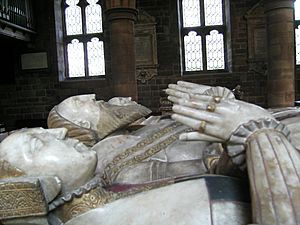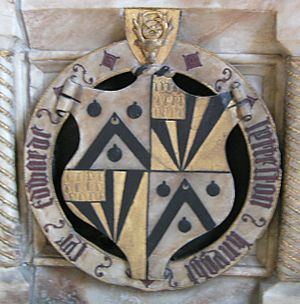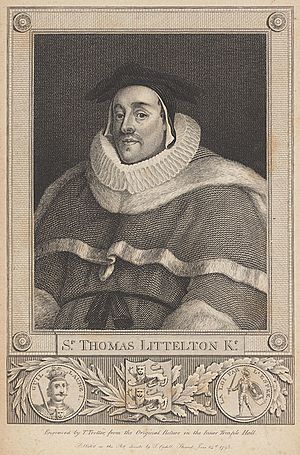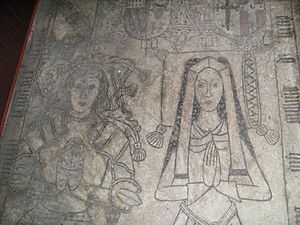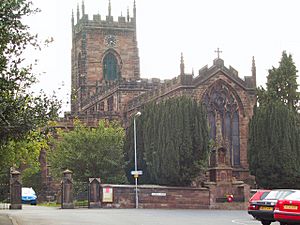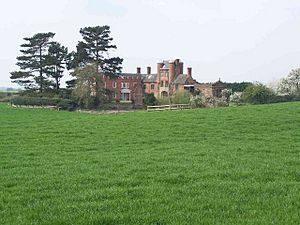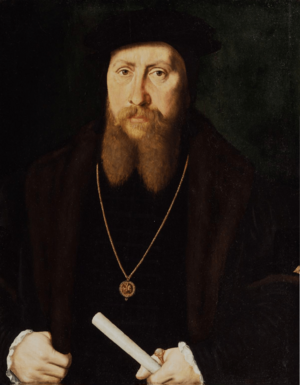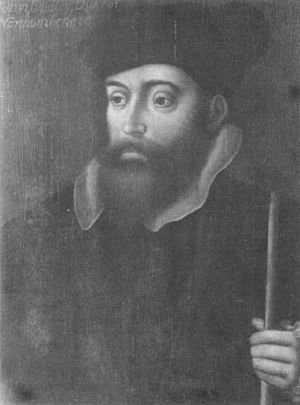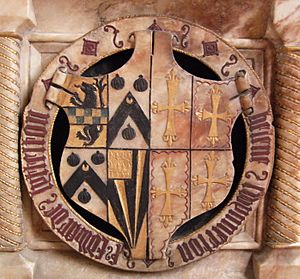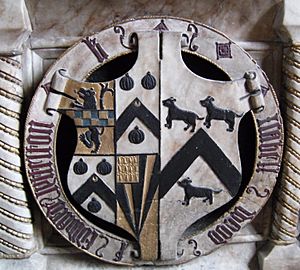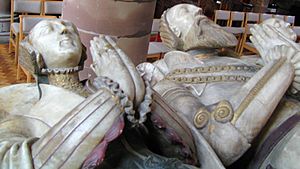Edward Littleton (died 1558) facts for kids
Edward Littleton (born by 1489 – died 1558) was an important landowner in Staffordshire, England. He came from the well-known Littleton/Lyttelton family. Edward also served as a soldier and was elected five times as a Member of Parliament (MP) for Staffordshire in the House of Commons of England. This was the lower house of the Parliament of England.
Contents
Edward's Early Life and Family
Edward Littleton's father was Richard Littleton. Richard was a younger son of Thomas de Littleton, a very famous judge from the 1400s. Richard moved to Staffordshire, his mother's home county. There, he worked for Edward Stafford, 3rd Duke of Buckingham, a powerful noble.
Edward's mother was Alice Wynnesbury. She was the only child of William Wynnesbury, who owned the Pillaton and Otherton estates near Penkridge. When her father died in 1502, Alice inherited these lands, including the old moated manor house called Pillaton Hall. Richard Littleton died in 1517, and Alice died 12 years later. After her death, the Wynnesbury estates officially became part of the Littleton family's property.
Edward likely studied law at the Inner Temple, a famous law school where his grandfather had also studied.
Becoming a Soldier and Royal Official
Around 1512, Edward joined the army for King Henry VIII. This was part of a war against France. In 1513, Littleton fought in Henry's invasion of northern France. His troops helped defeat the French at the Battle of the Spurs. They then captured the important town of Tournai.
Edward's friend in this war was Sir John Giffard from Chillington Hall. Sir John was a neighbor who fought bravely. It was probably Sir John who helped Edward get several important jobs. These jobs were both at the royal court and in Staffordshire.
After his father Richard died in 1516, Edward gained more property. This made him more important locally. In 1521, the Duke of Buckingham was executed. This opened up many new opportunities in Staffordshire. Edward became an escheator for Staffordshire in 1517–18. An escheator was an official who managed property that went back to the king if someone died without an heir.
By 1522, he was appointed a Gentleman Usher, which was a special honor at court. Around the same time, he became the constable of Stafford Castle and the Keeper of Stafford Park. He was also the bailiff of Forebridge. These honors led to him becoming High Sheriff of Staffordshire in 1523–24. He served as High Sheriff again in 1539–40. The High Sheriff was a very important local official, responsible for law and order.
Edward's Time in Parliament
When his mother Alice died in 1529, Edward inherited the Pillaton and Otherton estates. This included Pillaton Hall, making him a much more powerful person in the area. Within months, he was elected as one of Staffordshire's two Knights of the Shire. This title meant he was a county representative in Parliament, but it didn't mean he was a knight yet. His senior colleague was his friend, Sir John Giffard.
The Reformation Parliament
The Parliament elected in 1529 was known as the Reformation Parliament. It lasted for six and a half years. In its early years, this Parliament passed laws to reduce the power of the clergy (church leaders). They especially wanted to lessen the power of the Pope. King Henry VIII was in constant disagreement with the Pope. This was because Henry wanted to end his marriage to Catherine of Aragon.
In 1533, Parliament passed the Statute in Restraint of Appeals. This law stopped all appeals to the Pope. Thomas Cromwell, who planned this law, listed Littleton and Giffard as being against it. However, Edward Littleton generally supported the changes of the Reformation. Both Giffard and Littleton were keen to buy lands that became available. These lands came from the Dissolution of the Lesser Monasteries Act. This was a major law passed in the last session of the 1529–36 Parliament.
Littleton and Thomas Giffard, Sir John's son, were elected to Parliament again in 1536. This was with the king's approval. This Parliament lasted until 1539. It passed the Second Act of Dissolution, which took over the lands of the larger religious houses. Littleton did not serve in Parliament again until 1553.
Serving Under Queen Mary I
In August 1553, Queen Mary, King Henry VIII's Roman Catholic daughter, called her first Parliament. In September, the local gentry (landowners) met in Stafford. They quickly elected Sir Thomas Giffard as one of their representatives.
Baron Stafford wanted his son, Henry, to have the other county seat. He had two allies, Sir George Griffith and Humphrey Welles, manage the election. However, Littleton had argued with the Staffords. They used to be friends, but they fell out over fishing rights on the River Penk near Dunston.
When young Henry Stafford was cheered as Giffard's colleague, Littleton stepped in. He demanded a poll, which is a formal vote. He convinced the High Sheriff, George Blount, to start the poll by checking Stafford's supporters. Many of Stafford's supporters then left. This allowed Littleton to win with 248 votes. Baron Stafford complained to the Privy Council, a group of royal advisors. He claimed the Sheriff had also treated his son unfairly in an earlier election. Littleton took his case to the Lord Chancellor, Stephen Gardiner, who ruled in his favor. This argument caused lasting bad feelings between the Staffords and the Littletons. Edward Littleton was made a knight in October when Parliament met.
Littleton seemed to accept, rather than fully welcome, the return of Catholicism under Queen Mary. The lands gained from the monasteries were not taken back. So, landowners like Littleton kept their new wealth. Littleton's views were not strong enough to get him into the next Parliament in spring 1554. However, he was elected for the second Parliament of that year. His stepson, Sir Philip Draycott, was the other MP. He was also elected for the 1555 Parliament, again with Sir Thomas Giffard.
Edward's Religious Views
Littleton seemed to hold traditional religious beliefs. He was against the first break with the Pope. His friends, like the Giffards, also had similar views. However, none of them opposed changes that helped landowners. This included the closing of the monasteries. Unlike some northern landowners who rebelled in the Pilgrimage of Grace, the Staffordshire gentry, including Littleton, eagerly bought the newly available land.
Littleton's most notable involvement in a religious issue was in the case of George Blagge. Blagge was an MP for Bedford. In 1546, Blagge was tricked into denying the importance of the Mass. He was immediately arrested and sent to prison. At his trial, Littleton and Sir Hugh Calverley were the main witnesses against him. Based on their evidence, Blagge was sentenced to be burned for heresy. Luckily, a powerful lord, John Russell, appealed to the king. King Henry, who hadn't known about the trial, immediately pardoned Blagge and ordered his release.
It seems Blagge's real "crime" was speaking out against Thomas Howard, 3rd Duke of Norfolk, a very powerful man. Blagge worried Norfolk would have too much influence over the future King Edward VI. By testifying against Blagge, Littleton was, perhaps unknowingly, helping the Howard family. King Henry soon acted against the Howards himself. So, Littleton's role in this case did not make the king happy. This might be why Littleton stayed out of Parliament for some years.
Edward as a Landowner
Edward Littleton worked hard to increase his family's land holdings. He took advantage of the big changes in land ownership during the Tudor dynasty. This included the closing of monasteries and chantries (chapels where prayers were said for the dead). These changes created many opportunities. Edward was often involved in litigation (legal disputes) to achieve his goals.
Pillaton, with its manor house, originally belonged to Burton Abbey. After the monasteries were closed, the king took ownership. In 1546, King Henry VIII gave it to Sir William Paget. The Paget family owned it for at least 200 years. However, the Littletons, as the actual residents, were secure in their possession of Pillaton. When Edward Littleton died in 1558, they paid only 16 shillings a year in rent. But the estate itself was worth much more, about £15 a year.
Acquiring More Land
Black Ladies Priory, a small religious house near Brewood, was closed in 1536. Littleton and Thomas Giffard both asked the King to buy its land. Littleton got support from Bishop Rowland Lee. The issue went to Thomas Cromwell, who decided to sell to Giffard. Giffard bought the priory site and lands for £134. This competition for the priory didn't seem to harm the friendship between Giffard and Littleton.
Haughmond Abbey in Shropshire was a much larger property. It became available after the Second Dissolution Act of 1539. Bishop Lee also supported Littleton in his bid to buy this Abbey. Edward acquired it in 1540. Two years later, he sold it, likely for a profit, to Rowland Hill. Hill was a businessman from Shropshire who later became Lord Mayor of London.
In 1543, Littleton leased the deanery manor of Penkridge. This was from the church of St. Michael and All Angels. This lease included the church site, buildings, and farmlands around the town. The deanery manor had existed since the 1200s. The church was a Royal Peculiar, meaning it was under the king's direct control.
However, the deanery and college were soon closed by the dissolution of the chantries in 1547. The Crown then gave the deanery manor to John Dudley, Earl of Warwick. Dudley was a very ambitious member of King Edward VI's government. Dudley also owned Penkridge manor itself.
Warwick, who later became Duke of Northumberland, had to honor the deanery's existing leases. So, Littleton continued to lease the estate and pay annual rent. The property was valued at over £82 a year in 1547. Littleton's efforts to get the most out of the deanery manor led to his dispute with Baron Stafford. Stafford believed that Northumberland's great power was protecting Littleton when he was in the wrong. When Northumberland fell from power at the start of Queen Mary's reign, the deanery manor returned to the Crown. But the Littletons continued to lease it. In the 1580s, Edward's grandson was finally able to buy the estate.
Another very important acquisition for the Littleton family was Teddesley Hay. This area was part of the royal forest of Cannock. It was given to Dudley in 1550. After Dudley was executed in 1553, it went back to the Crown. Dudley's widow was given the right to use it from 1554. However, she died a year later, and Littleton was able to buy Teddesley Hay. Two hundred years later, it became the site of a new home for the Littletons: Teddesley Hall.
Edward Littleton clearly became very rich and powerful in his local area through these many land deals. Both Pillaton Hall and the Penkridge parish church were greatly changed in the early to mid-1500s. The hall was rebuilt in the Tudor style. The church gained a Littleton family chapel and was partly rebuilt in the Perpendicular style. It had an impressive square tower and new windows. Edward must have played a big part in these changes.
What People Thought of Edward
When Edward Littleton was sued by the son of a historian named Sampson Erdeswicke, he was described as: "a man of great lands [who] beareth all the rule in those parts of the shire, and is greatly friended and allied." This was meant as a criticism, suggesting he was too powerful.
Baron Stafford, who used to be Edward's friend but became his main enemy, described him later in life: "after his ... dissembling fashion offered to have taken me by his hand and I told him he should neither have hand or heart of me for his evil, false and untrue report of me ... to the lord chancellor." This shows that some people thought Littleton was dishonest. It seems some people saw Edward as someone who rose up quickly. While the old nobility followed traditional ways, Littleton and other landowners were like rural business people. They made their fortunes in a changing economy.
Edward's Marriages and Family
Edward Littleton married twice:
- Helen Swynnerton: She was his first wife, daughter of Humphrey Swynnerton. They married before 1527. They had two sons and two daughters.
- Isabel Wood: Her father is not known. They married before April 1533. Isabel had been married twice before. First to Ralph Egerton, and then to Sir John Draycott.
Edward Littleton died on October 10, 1558, at Pillaton Hall. He was buried in St. Michael's church, likely in the family chapel. A large alabaster tomb was placed there for him and both his wives. This tomb was later moved to the south side of the chancel (the area around the altar), where it still is today.
His son, also named Edward Littleton, inherited his estates. This son was from his first marriage to Helen Swynnerton.
See also
- History of Penkridge
- Littleton Baronets


